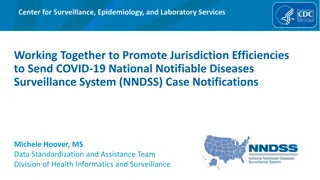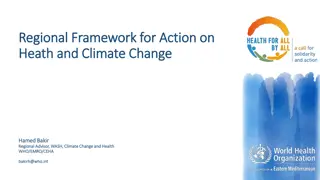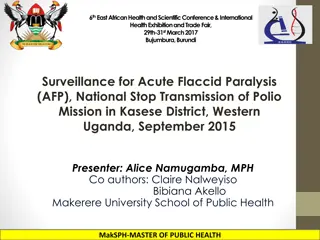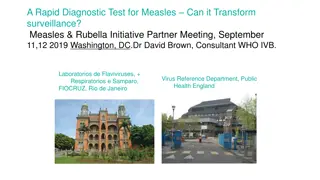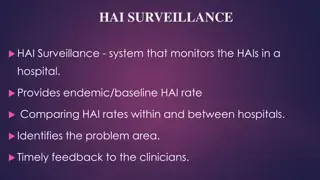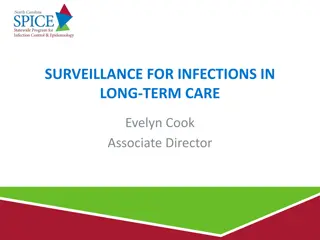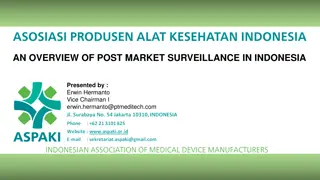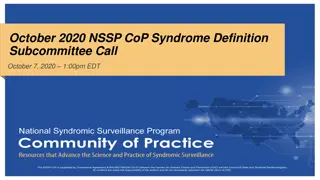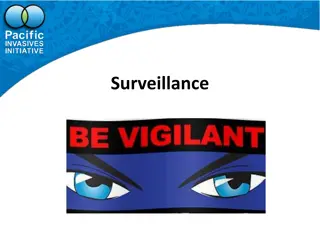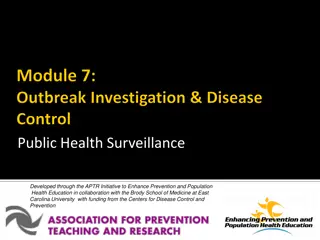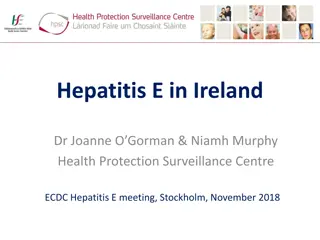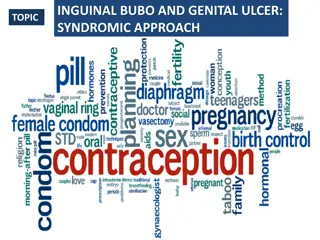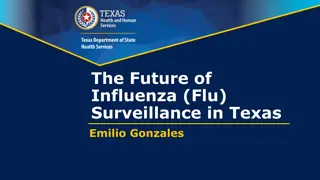Harnessing Syndromic Surveillance Systems for Climate-Related Outcomes
Utilizing syndromic surveillance systems can provide valuable insights into the impact of climate change on health outcomes. This document aims to guide users on identifying outcomes, creating case definitions, combining data sources, and engaging with partners for effective climate and health surveillance. It emphasizes the importance of understanding and accounting for multiple outcomes related to weather patterns and environmental exposures, and offers a structured approach to developing case definitions for surveillance objectives.
Download Presentation

Please find below an Image/Link to download the presentation.
The content on the website is provided AS IS for your information and personal use only. It may not be sold, licensed, or shared on other websites without obtaining consent from the author.If you encounter any issues during the download, it is possible that the publisher has removed the file from their server.
You are allowed to download the files provided on this website for personal or commercial use, subject to the condition that they are used lawfully. All files are the property of their respective owners.
The content on the website is provided AS IS for your information and personal use only. It may not be sold, licensed, or shared on other websites without obtaining consent from the author.
E N D
Presentation Transcript
1 Utilizing syndromic surveillance systems for climate-related outcomes Laurel Harduar Morano International Society of Disease Surveillance
2 Why did we create the document? Climate change broad range of adverse outcomes Climate and health surveillance embryonic phase [Moulton 2017] Syndromic surveillance systems (SyS) can help Situational awareness Unique data fields/sources
GOAL = General instruction on using SyS for climate and health surveillance 3 1. Identify an outcome 2. Creating a case definition, 3. Combining SyS data with environmental data 4. Data display and interpretation 5. Engaging with partners
4 Quick note Climate = long-term variation in weather patterns Public health surveillance: climate = short term and long-term meteorological events
Section I 5 Identifying an outcome 1. Directly related to current/forecasted weather patterns 2. Related to environmental exposures
Section I 7 Identifying an outcome 1. Directly related to current/forecasted weather patterns 2. Related to environmental exposures 3.Understand/account for multiple outcomes for a single event
Section I 8 Single event multiple outcomes
Section I 9 Identifying an outcome 1. Directly related to current/forecasted weather patterns 2. Related to environmental exposures 3. Understand/account for multiple outcomes for a single event 4. How/where/when - health impacts will vary by regions/cities and populations
Section II 10 Developing a case definition 1. Decide surveillance objective 2. Definition based on keywords, diagnosis codes, or both 3. Select the keywords and/or diagnosis codes 4. Validate and refine 5. Restriction by other factors 6. Evaluate the effectiveness
Section II 11 Keywords Identify based on another jurisdiction
12 The symbol for wildcard (^ or *) varies by syndromic surveillance system. For ESSENCE a subtotal of 6 points are required for a visit to be captured.
Section II 13 Keywords Identify based on another jurisdiction Identify keywords based on diagnosis codes Identify keywords based on an event Identify keywords based on an activity Identify keywords by speaking with partners Identify keywords by machine learning
Section II 14 Diagnosis codes Identify based on another jurisdiction or published papers Identify by searching the code manual *Example only not an endorsement
Section II 15 Other Factors Potentially multiple etiologies (e.g. fire or non-fire related CO poisoning) Timing (e.g., summer only, event only) All ED visits
Section II 16 Validate/evaluate effectiveness Manual review Identify a gold standard calculate performance measures Temporality comparison [Berry 2013]
Section III 18 SyS and Environmental Data 1. Identify goal and potential uses of surveillance 2. Identify the appropriate types of data 3. Identify data source 4. Ask permission to use data 5. Temporally and geographically match the data 6. Maintain a working relationship with environmental data steward 7. Demonstrate use
Section III 19 SyS and Environmental Data 4. Temporally and geographically match the data 5. Add environmental data as a new data to SyS 6. Validate environmental data 7. Maintain a working relationship with environmental data steward 8. Demonstrate use
Section IV 20 Interpretation and display Case definitions applied to differing geographic levels Data presented in tabular form, graphs, maps Stratified by demographic group Counts, percent of total visits, rates
Section IV 21
Section IV 22 Asthma-like Visits from Multnomah County Residents and Portland Air Quality, February 2017
Section V 24 Identify/engage partners Identify partners early Use your data to identify partners Expand and build your network Share your data
25 Conclusion: Guidance Document Initial steps to develop and expand surveillance of weather- and climate-related health outcomes Chock full of examples and references
26 References Berry M, Fagliano J, Tsai S, McGreevy K, Walsh A, Hamby T. Evaluation of Heat-related Illness Surveillance Based on Chief Complaint Data from New Jersey Hospital Emergency Rooms. Online Journal of Public Health Informatics. 04/04 2013;5(1):e125. Moulton AD, Schramm PJ. Climate Change and Public Health Surveillance: Toward a Comprehensive Strategy. J Public Health Manag Pract. 2017 Feb 6.
27 Currently available resources Heat-related illness syndrome query: a guidance document for implementing heat- related illness syndromic surveillance in public health practice (http://www.cste.org/group/ClimateChange) Utilizing syndromic surveillance systems for climate-related outcomes (CSTE Webinar Library: http://www.cste.org/?page=WebinarLibrary)
28 Laurel Harduar Morano, PhD International Society for Disease Surveillance onarom.lh@gmail.com ISDS website: www.healthsurveillance.org Thank you to CSTE for funding this project!





